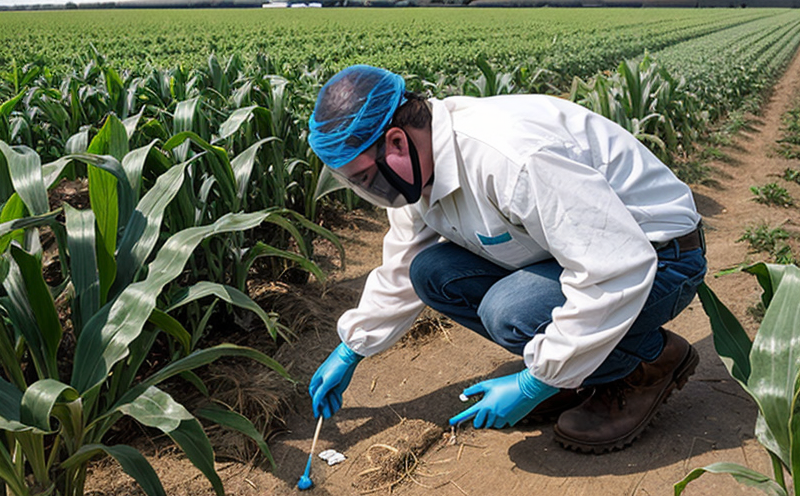Bendiocarb Residue Testing in Crops
Bendiocarb residue testing in crops is a critical process that ensures compliance with regulatory standards and maintains consumer safety. Bendiocarb, a synthetic pyrethroid pesticide, has been widely used for controlling insect pests in agriculture since its introduction. However, the use of pesticides like bendiocarb can pose risks if not monitored properly, leading to potential health hazards and environmental impacts.
The testing process involves several steps, starting with sample preparation. Crop samples are collected from fields where bendiocarb has been used, following established protocols. These samples must be representative of the entire batch to ensure accurate results. Once collected, the samples undergo a rigorous extraction process using solvent techniques such as QuEChERS (Quick, Easy, Cheap, Effective, Rugged, and Safe) or other appropriate methods to separate the pesticide residues from the matrix.
After extraction, the sample is analyzed using advanced analytical instrumentation. High-performance liquid chromatography (HPLC), coupled with mass spectrometry (MS/MS), is commonly used for its high sensitivity and specificity in detecting pesticides like bendiocarb. The method of analysis must be validated according to international standards such as ISO 17025, ensuring the reliability and accuracy of the test results.
The acceptance criteria are stringent, requiring that the pesticide residue levels do not exceed the maximum residue limits (MRLs) specified by regulatory bodies like the Food and Agriculture Organization of the United Nations (FAO) and the World Health Organization (WHO). The MRL for bendiocarb is set at 0.5 mg/kg in most crops, but this may vary based on specific crop types.
The importance of this testing cannot be overstated. Quality managers rely on accurate residue levels to ensure that products meet quality standards and are safe for consumption. Compliance officers need these results to avoid legal penalties from non-compliance with pesticide regulations. R&D engineers use the data to optimize pest control strategies, while procurement teams can verify the integrity of their supply chain by ensuring that only compliant products enter their processes.
The process also involves detailed documentation and reporting. The final report should include all relevant information such as sample identification, test method used, results obtained, and compliance status against MRLs. This data is crucial for decision-making at various levels within the organization, from field management to executive leadership.
Given the complexity of pesticide residue testing, it's essential to work with a reputable laboratory that has expertise in this area. Our lab offers state-of-the-art facilities and experienced staff who can provide precise results, ensuring confidence in both the product quality and regulatory compliance.
Scope and Methodology
The scope of bendiocarb residue testing encompasses a wide range of crops where this pesticide is commonly used. This includes fruits like apples, pears, and citrus; vegetables such as tomatoes, peppers, and leafy greens; and various field crops like corn, wheat, and rice. The methodology involves several key steps:
- Sample Collection: Samples are collected from fields where bendiocarb has been used, following strict protocols to ensure representativeness.
- Extraction: Extraction methods such as QuEChERS or similar techniques separate the pesticide residues from the matrix.
- Analytical Instrumentation: HPLC-MS/MS is typically used for its high sensitivity and specificity in detecting bendiocarb residues.
- Validation: The method of analysis must be validated according to ISO 17025 standards, ensuring reliability and accuracy.
The acceptance criteria are based on the maximum residue limits (MRLs) set by regulatory bodies. For instance, in apples, pears, and citrus, the MRL for bendiocarb is 0.5 mg/kg, while other crops may have different limits depending on the specific crop type.
Benefits
The benefits of conducting bendiocarb residue testing are multifaceted, impacting various stakeholders within the agricultural and food supply chain:
- Consumer Safety: Ensures that crops meet safety standards and do not pose risks to human health.
- Regulatory Compliance: Helps organizations avoid legal penalties by ensuring compliance with pesticide regulations.
- Pest Management Optimization: Provides data for optimizing pest control strategies, enhancing crop yields.
- Supply Chain Integrity: Verifies the integrity of supply chains by ensuring only compliant products enter processes.
In addition to these benefits, regular testing also promotes sustainable agricultural practices. By monitoring pesticide residues, farmers can make informed decisions about when and how much pesticide to use, reducing overuse and minimizing environmental impact. This not only protects ecosystems but also ensures long-term sustainability of agricultural resources.
Use Cases and Application Examples
The application of bendiocarb residue testing in crops is extensive, with various use cases across different sectors:
- Farm Management: Farmers can use test results to adjust their pesticide usage strategies, ensuring optimal crop health without overuse.
- Supply Chain Verification: Procurement teams can verify that only compliant products enter their supply chains, maintaining the integrity of their processes.
- R&D Innovation: Researchers and developers use test data to innovate new pest control methods and improve existing practices.
- Market Access: Exporters ensure that their crops meet international standards, facilitating market access in foreign markets.
A practical example is a large-scale apple orchard that uses bendiocarb for pest management. Regular residue testing ensures that the apples meet MRLs set by regulatory bodies such as FAO and WHO. This not only protects consumer health but also facilitates easier export to countries with stringent import regulations.





